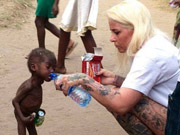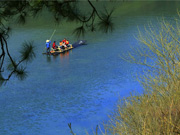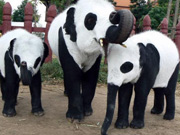

Scientific personnels work at the landing area of the re-entry capsule of China's first retrievable microgravity satellite SJ-10 in Siziwang Banner, North China's Inner Mongolia autonomous region, April 18, 2016.[Photo/Xinhua]
Experiments conducted on SJ-10
Silkworm embryoswere taken into space for a biology experiment designed to observe the embryos' genetic reaction to cosmic radiation. Although silkworm embryos had been observed in previous research, there was not enough data to know if genetic mutations occurred at different stages of development. This time the researchers divided the embryos into six groups, so that one group stopped developing every two days, providing a better picture of the mutation process over time.
An experimentusing 6,000 mouse embryos to measure the effect of a gravity-free environment on living organisms found that some of the embryos completed the full development process into blastocysts-a cluster of cells that can be implanted into a womb. It is the first evidence in human history that early-stage mammal embryos can develop in space.
Human stem cellsare being used for experiments in cell differentiation as part of the satellite's biotechnology research. Stem cells can differentiate into specialized cells and also produce more stem cells. They are considered a key source for regenerative medicine. The SJ-10 carried experiments on cell cultures of hematopoietic stem cells and neural stem cells, and explored the differentiation mechanism of human bone stem cells.
 |  |
Day|Week

 Female official wearing traditional Han costume to promote local tourism
Female official wearing traditional Han costume to promote local tourism Over 12,000 Runners Seek Medical Care in S China’s Marathon
Over 12,000 Runners Seek Medical Care in S China’s Marathon Six Luxury Sports Cars Totaled after Fail Attempts to Cross China’s Most Perilous Highway Linking SW China’s Sichuan and Tibet
Six Luxury Sports Cars Totaled after Fail Attempts to Cross China’s Most Perilous Highway Linking SW China’s Sichuan and Tibet Incredible Transformation: “Witch Child”Whose Parents Left Him for Dead in Nigerian Makes Speedy Recovery
Incredible Transformation: “Witch Child”Whose Parents Left Him for Dead in Nigerian Makes Speedy Recovery Kenyan woman's crappy photoshopped pictures make her a web celebrity
Kenyan woman's crappy photoshopped pictures make her a web celebrity Magnificent view of E. China's Anhui province
Magnificent view of E. China's Anhui province Global landmarks captured in striking shots
Global landmarks captured in striking shots Thailand Elephants Disguised as Pandas Sparks Debates
Thailand Elephants Disguised as Pandas Sparks Debates College girl dresses as mermaid to mark World Water Day
College girl dresses as mermaid to mark World Water Day J-15 fighters in drill on Chinese aircraft carrier
J-15 fighters in drill on Chinese aircraft carrier